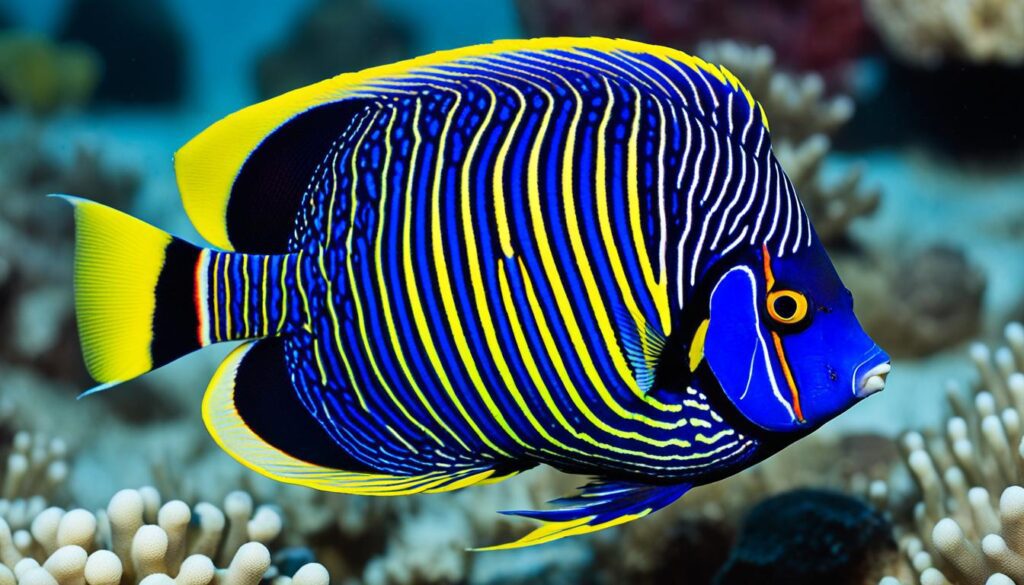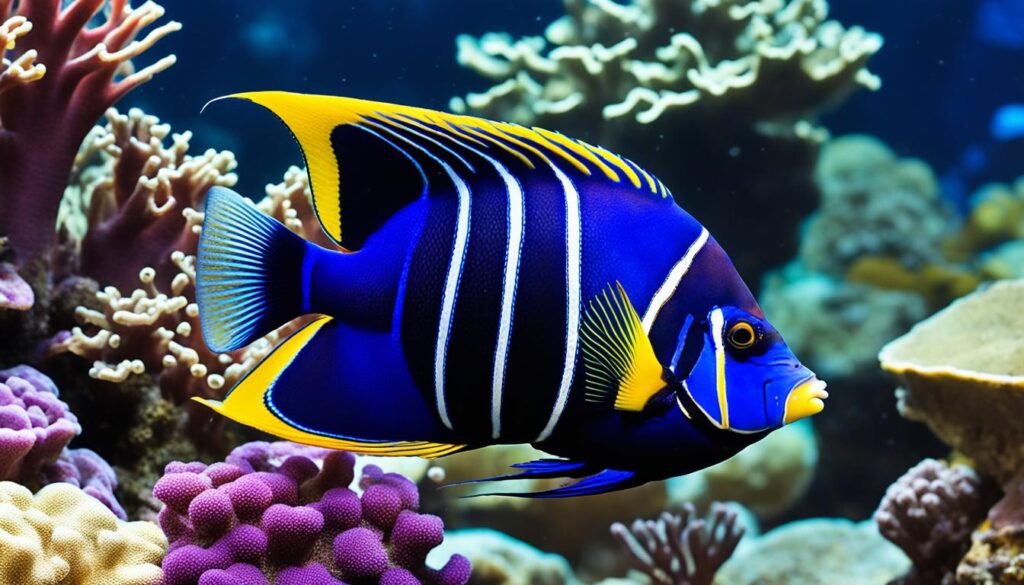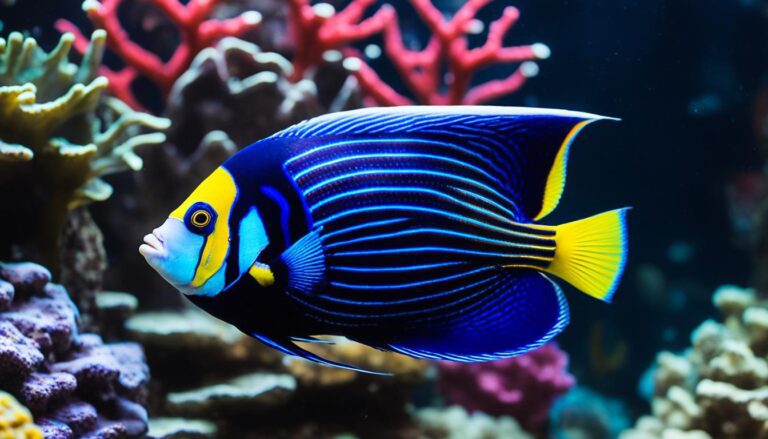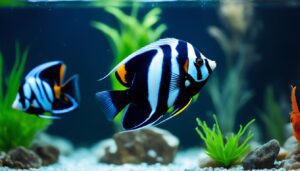Looking into my saltwater aquarium, I was amazed by my emperor angelfish’s stunning patterns and colors. These fish, part of the Pomacanthidae family, are a top pick for reef tank lovers. Their size and semi-aggressive nature make them a sight to see.
My first emperor angelfish was a real treat. The mix of royal blue, black, and white stripes was captivating. As they grew, their colors shifted to bright yellow and dark blue stripes, making them even more striking. It’s clear why emperor angelfish, also known as imperator or imperial angelfish, are pricey marine fish.
These fish can reach up to 15 inches (38 cm) long, so they need a big space. I learned that a 100-gallon (568 liters) tank is the minimum for their well-being. They also need plenty of live rock for hiding spots and a natural setting.
Emperor Angelfish Spotlight

The Emperor Angelfish is a stunning fish from the Indo-Pacific region. It’s highly sought after in the aquarium trade. Its vibrant colors and patterns make it a favorite among marine enthusiasts. Let’s explore more about this fish, including its scientific name, common names, origin, and where it lives.
Scientific Name and Common Names
The Emperor Angelfish is known scientifically as Pomacanthus imperator. Marcus Elieser Bloch, a German doctor and naturalist, named it in 1787. It’s also called Imperator Angelfish and Imperial Angelfish.
Origin and Natural Habitat
Emperor Angelfish come from the Indo-Pacific region. They live from the Red Sea to Hawaii and the Austral Islands. They also live in Mozambique, Madagascar, and across the Indian and Pacific Oceans.
In the north, they go up to Japan’s Kansai region. In the south, they’re found at the Great Barrier Reef in Australia, New Caledonia, and the Austral Islands in French Polynesia.
They live in shallow waters on coral reefs. Young ones hide under ledges. As they grow, they move to reef holes in surge channels. Adults live in caves and ledges in calm reef waters, often with a mate or in groups.
Distribution |
Depth Range |
|---|---|
Red Sea to Hawaii and the Austral Islands |
1 to 100 meters (3.3 to 328.1 ft) |
Southwards to Mozambique and Madagascar |
Shallow waters along coral reefs |
Eastwards through the Indian and Pacific Oceans |
Juveniles: Under ledges |
North to the Kansai region in Japan |
Subadults: Reef holes along surge channels |
South to the Great Barrier Reef of Australia, New Caledonia, and the Austral Islands in French Polynesia |
Adults: Caves and ledges in calmer reef waters |
Physical Characteristics and Size

The Emperor Angelfish is a stunning fish that changes a lot in color and size as it grows. Young ones have a black body with white and blue stripes, making them blend into coral reefs. This helps them hide from predators.
When they get older, Emperor Angelfish show off bright blue and yellow stripes. They also get a black mask around their eyes and a white snout. This change happens over about 2 years, showing how they grow and change.
Juvenile vs Adult Coloration
The Emperor Angelfish changes a lot in color from being young to an adult. The shift from a hidden pattern to bold stripes is amazing. Let’s see how they change:
Juvenile Coloration |
Adult Coloration |
|---|---|
Black body with C-shaped white and blue bands |
Horizontal stripes of blue and yellow |
Blue scale-like patterned fins with white edges |
Black mask-like band covering the eyes, edged in blue |
Intricate pattern for camouflage against coral reefs |
White snout and mouth area |
Average Size in Captivity and the Wild
In the wild, Emperor Angelfish can grow up to 15 inches long. But in tanks, they usually get to about 12 inches. Giving them a big tank and the right food helps them grow to their full size.
Emperor Angelfish grow to their adult size in 2 to 3 years. During this time, they change a lot in color. Their stripes get more colorful and clear as they get older.
Emperor Angelfish Tank Requirements

Keeping the majestic Emperor Angelfish in your aquarium requires the right tank setup. They need a big space to swim and water that’s just right for them. This is key for their health and happiness.
Minimum Tank Size
Emperor Angelfish can grow up to 12 inches long. So, a tank of at least 220 gallons is needed for one adult fish. If you have juveniles, about 2″ to 3-1/2″ big, a 125-gallon tank is okay at first. But remember to think about their growth and get a bigger tank later.
Water Parameters
Keeping the water perfect is vital for your Emperor Angelfish. They like the water to be between 72-82°F (22-27°C), with 77°F (25°C) being best. The pH should be 8.1 to 8.4, and the hardness 8-12 dKH. Aim for a specific gravity of 1.020-1.025, with 1.023 ideal.
Testing the water often is a must to keep your Emperor Angelfish healthy. Use a good testing kit and check the water every week. This helps you spot any changes and fix them fast.
Tank Setup and Decorations
Setting up your tank should mimic their natural home. Live rock is a must, offering food and places to hide. Use a lot of live rock to create caves and spaces for your fish to explore.
Choose corals wisely when adding them to your tank. Some corals don’t mix well with Emperor Angelfish because they like to nibble on them. But, they can live with certain corals like small-polyped stony corals and some soft corals.
Parameter |
Recommended Range |
|---|---|
Temperature |
72-82°F (22-27°C) |
pH |
8.1-8.4 |
Water Hardness |
8-12 dKH |
Specific Gravity |
1.020-1.025 (optimal: 1.023) |
A good filtration system is key for a healthy tank. It keeps the water clean by removing waste. Strong lighting also helps bring out your Emperor Angelfish‘s colors and can prevent disease.
With a big tank, the right water, live rock, chosen corals, and good filtration and lighting, you can make a great home for your Emperor Angelfish. They’ll thrive in such an environment.
Lifespan and Care Difficulty

As an emperor angelfish enthusiast, I can say they live a long time with the right care. In captivity, they can live over 20 years. In the wild, they might live even longer. But, their long life depends on how well they are cared for.
These fish are very sensitive and need clean water to stay healthy. They can easily get sick from stress, like ich, marine velvet, and head and lateral line erosion. To keep them healthy, it’s key to keep the water clean and reduce stress.
Changing the water regularly is important for their care. I suggest changing 10-15% of the water every two weeks, especially if you have coral in your tank. Keeping an eye on the water’s condition helps prevent diseases. Try to keep the water in these ranges:
Parameter |
Ideal Range |
|---|---|
Water Temperature |
72°F – 82°F |
pH Levels |
8.1 – 8.4 |
Water Hardness |
8 – 12 dKH |
Specific Gravity |
1.020 – 1.025 |
Even though emperor angelfish live a long time, they need a lot of care. Being a responsible aquarist is very rewarding. It lets me give my emperor angelfish the best home to live and show off their beautiful colors for years.
Diet and Feeding Habits

Emperor Angelfish are omnivorous, meaning they eat a mix of foods in the wild and in tanks. Young ones need to eat more often to grow and develop well.
Wild Diet
In the wild, Emperor Angelfish clean other fish by eating parasites and dead skin. They also eat algae, sponges, and other plants and animals on coral reefs.
Recommended Foods in Captivity
To keep Emperor Angelfish healthy in tanks, feed them a variety of foods. This includes:
- High-quality marine pellets or flakes
- Frozen foods like shrimp, scallops, and squid
- Fresh or dried algae and vegetables like spinach
- Live rock for them to graze on
It’s hard to keep sponges in tanks, but there are special frozen foods for angelfish to help their diet.
Feeding Frequency and Amounts
When you first put juvenile Emperor Angelfish in a tank, feed them small amounts 5 times a day. As they get bigger, switch to feeding them 3 times a day. Only give them food they can eat in 5 minutes to keep the water clean.
Life Stage |
Feeding Frequency |
Amount per Feeding |
|---|---|---|
Juvenile |
5 times daily |
Small portions |
Adult |
3 times daily |
Amount consumed within 5 minutes |
Let Emperor Angelfish graze on live rock and other tank surfaces between meals. A varied diet and mimicking their natural eating habits will keep these beautiful fish healthy and happy.
Emperor Angelfish Behavior and Tank Mates
Emperor Angelfish are semi-aggressive and very territorial. Males often fight over space, so keep only one male per tank. A large aquarium is needed for a bonded pair with a female.
Choosing the right tank mates is key. These fish may bother smaller, peaceful fish and eat crustaceans and invertebrates. They’re not reef safe, as they might nip at corals. For a peaceful tank, pair them with bold, semi-aggressive fish like large tangs, dottybacks, hawkfish, and triggerfish.
For Emperor Angelfish, a big tank is a must. A 200-gallon tank is ideal for one adult. A bonded pair needs a 185-gallon tank. A large space helps reduce aggression and stress, making for a healthier fish. By picking the right tank mates, you can enjoy a beautiful and peaceful aquarium with Emperor Angelfish.








